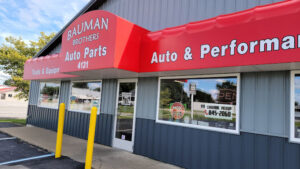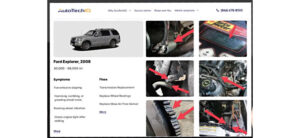AI offers various benefits that make it an appealing technology for repair shop owners, but there are pros and cons
Steven E. Schillinger is a P.E. and PBE consultant in addition to being “actively retired.” He can be reached at schillingersteven@gmail.com and linkedin.com/in/seschillinger.
Automotive Artificial Intelligence (AAI) has become an integral part of business for vehicle service and repair. Shop owners are implementing AAI technology that can mimic human intellect and change the way they repair cars.
AAI has already made tremendous achievements in enhancing the efficiency and productivity of several areas, ranging from wheel alignment to paint mixing to employee healthcare.

However, like any new technology, there are advantages and disadvantages that must be evaluated.
AAI refers to the ability to execute tasks that normally need human intelligence. Simply put, AI imitates how a human would perform a task using cognitive abilities like reasoning, learning, problem-solving, and decision-making.
Before the pandemic, about 15 percent of US auto claims were settled using photos rather than in-person visits by adjusters, says Bill Brower, the head of Auto Claims at LexisNexis Risk Solutions, a data and analytics company. Now, it’ at 60 percent, and he expects it to reach 80 percent by 2025.
Simulated estimates seem to be very good at separating out, within a matter of seconds, vehicles that can be fixed from vehicles that should be totaled. Experts say they’re also good at evaluating minor vehicle damage, from crashes where no one is hurt. These make up the majority of incidents, so in many cases, “photo-based estimates work best,” said Alex Dalyac, CEO of Tractable, an artificial intelligence company specialized in visual tasks and hopes their algorithms can evolve into agreed-upon standards that will reduce disputes between insurance companies and repair shops.
“A photo is worth a thousand words, but it doesn’t come up with the real value of the damage,” says Mike LeVasseur, who directs the collision division at the Automotive Service Association.
“The mindset for many shops is that productivity takes precedence and compliance issues can be easily be put off until tomorrow” states Rob Dolezal of Clean Room Paint Shop.
Life on the floor of an automotive facility is hectic. There are deadlines to meet, quotas to reach and new problems to solve every day. For many managers, keeping up with production schedules and overseeing employees is a huge challenge.
Add the regulatory complexities of the Resource and Recovery Act of 1976 (RCRA) and the requirement to operate within the scope of hazardous waste compliance, and now you have an overburdened staff.
The most worrying downside of AI is that it has the potential to replace technicians. AI might result in job displacement and unemployment in certain areas. This can result in social and economic inequity, posing a challenge to governments and society. As per a recent analysis by McKinsey and Co., AI automation will displace over 400-800 million jobs by 2030!
The AAI suppliers acknowledge that their programs aren’t flawless. “This is new technology for the industry, and there are going to be some kinks in the system,” says Friedlander, the Insurance Information Institute spokesperson. “It’s an evolving system, and it will continue to get more precise and more accurate.”
AI offers various pros and cons that make it an appealing technology for auto shop owners and governments.
Pros for Auto Shop Artificial Intelligence
- AAI can accomplish things more quickly and precisely than humans. This can result in large increases in productivity and efficiency, particularly in areas requiring concern, such as collision avoidance system and healthcare.
- AAI automates repetitive and tedious processes, decreasing the requirement for human labor. Auto shops can still benefit from AAI’s capabilities without hiring an entire team of professionals and making infrastructural amendments for the same.
- AAI can analyze massive volumes of data and generate insights that can be used to inform decision-making. This is especially important in industries like auto repair, where AAI can analyze vehicle data and offer personalized solutions.
- AAI can be used to provide personalized customer service experiences at scale. For example, AAI-powered chatbots can answer customer questions in real-time and recommend products and services based on the customer’s individual needs. AAI can also analyze customer feedback and identify areas where service can be improved.
Cons for Auto Shop Artificial Intelligence
- Reliance on Data: Technologies such as AI depend on the quality of the data they are trained on. AI algorithms rely on data to learn and make decisions. If the data is biased or incomplete, the AI algorithm will reflect those limitations.
- Security Risks: AI can be vulnerable to cyberattacks, which can lead to data breaches and other security risks. This can be particularly problematic in industries that handle sensitive information, such as healthcare and finance.
- Existential Threats: Some experts are worried that AI could pose a threat to humanity if it becomes more intelligent than us and decides to work against us. This is a controversial topic, but it is important to think about the possible risks of AI as we develop and use more and more sophisticated AI systems.
- Makes Employees Lazy: AI can make us lazy by doing our work for us. This can lead to service or repair problems and neglect of important issues. AI can also be addictive and spending too much time on AI-powered devices can lead to neglect of significant matters.
There are both tangible and intangible pros and cons for implementing AAI. Monetary cost avoidance includes violation fines; healthcare expenses for employee treatments; worker compensation claim payouts and legal costs. Less quantifiable costs include productivity losses due to medical leaves, decreases in employee morale and damage to shop reputation. Therefore, the case is strong for AAI adoption in shop environmental and safety scenarios.
AAI and smart technologies for the auto industry are only a piece of the puzzle in the new Roaring Twenties — a resurgent era of technology-driven equity and economic expansion. Organizational culture and operational risk management processes are now equally important.
AI has the ability to alter industries and improve the way we live and work. It also raises worries about job displacement, economic injustice, and many ethical issues. As AI evolves and becomes more sophisticated, governments, the automotive industry, and society as a whole must examine its impact.
They should adopt rules to guarantee utilization, responsibly and integrity. Finally, to realize the benefits of AI, the development and application should be in a way that benefits society as a whole.
Special thanks to the following contributors: Wade Riddering @ wade@erc-llc.us; Barry Thomas @ bthomas@beccainc.com; Rob Dolezal @ rob@cleanroompaintshop.com; Regulatory @ Air Toxics in Collision Repair Shops; Steven Schillinger @ schillingersteven@gmail.com; Small Business Assistance @ Compliance Assistance












Comments are closed.